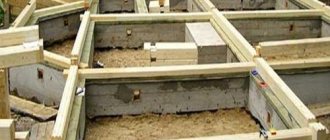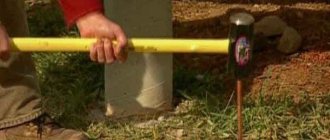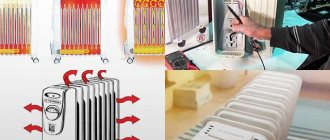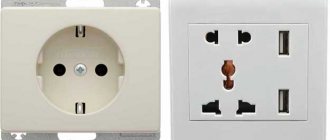To prepare mortars at home, use a concrete mixer. Using a special tool allows you to obtain a high-quality, homogeneous batch, increase productivity and reduce labor costs.
On the left is a professional construction mixer, on the right is a hammer drill with the ability to install a whisk.
Scope of application of hand mixer
To obtain large volumes of concrete solution on large construction sites, specialized equipment is required - a concrete mixer. For small construction in the private sector, a special hand mixer is suitable; its operating principle and design are similar to a simple drill.
The working tool is capable of preparing concrete, masonry and plaster mortars, paint and varnish mixtures, cement and other materials that are subsequently used for construction, finishing and repair and restoration work.
Flaws
- Fatigue. While working with a mixer, your arms and back get very tired.
- Time. It takes more time to mix the same amount of mass as with a concrete mixer.
- Solutions. It is not possible to mix solutions with large gravel elements. Also, there may not be enough power to knead particularly thick masses.
IMPORTANT. If it is not possible to purchase a concrete mixer or mixer, then you can use a hammer drill or drill (an electric one will not work because it will not have enough power). To do this, you need to get a special attachment, which costs a penny.
Variety of hand tools
There are 2 equipment options available on the domestic market:
- Hand mixer.
- Hammer drill with whisk mounting.
Depending on the volume of work performed, hand mixers can be either professional or household. The difference between them is power. Professional-class models are designed for mixing viscous concrete solutions, while household models are designed for lighter, liquid substances.
Hammer drills are devices with increased power and special attachments installed. They are suitable for light, gravel-free mixtures; otherwise, when mixing large volumes of heavy materials during operation, the mixer will overheat and quickly deteriorate.
The use of attachments expands the functionality of mixers. The selection takes into account the type and density of the material. The most popular among builders are hand tools with different shaft rotation speeds.
Three types of whisks for a construction mixer: screw (1), cross-shaped (2, 3), combined (3, 4).
Advantages of a hand mixer:
For example, let’s take the Fiolent MD1-11E mixer, Professional series, which has proven itself over several years of operation and costs 4,100 rubles in 2021.
Considering the cost of a budget concrete mixer is 10,000 rubles, the savings are significant. In our example, this is the third tool, and preference is again given to it.
There is a Master series, red, with an increased service life. According to the official website of Fiolent, the production life of blue is 150-180 hours, red - 220-250. In fact, the indicators are significantly higher, the last blue one lasted about a year, with merciless use in the construction of a cottage. Gearbox breakdowns and replacement of brushes do not cause any problems, all spare parts are available in service centers and cost pennies.
Lightweight and compact - can be transported without problems in any passenger car, unlike a concrete mixer, which can only be transported once, not yet assembled and clean, from the store. An indispensable tool in confined spaces and on floors.
Types of nozzles and their features
There are 3 types of nozzles:
- Screw. Used for mixing and diluting paints and varnishes. The special design of the device allows you to achieve good performance and prevents splashing.
- Cross-shaped. Mixes sealants, adhesive solutions, various fills well, and prevents air from entering the solution.
- Combined. Can be used for any components. Thus, for mixing dense concrete mortar from crushed stone and gravel, a cross-shaped equipment with a right-handed spiral is most suitable. During the technological process, heavy additives fall down, the spiral begins to lift them up, evenly mixing the components. The disadvantage of such attachments is the absence of a thrust ring, which is designed for ease of operation.
According to the method of fixation, the nozzles are divided into the following:
- with screwing into the hole of the device;
- using a cartridge clamp;
- with a fixing element.
The most common attachments are those that have an M14 chuck that is clamped with a serrated wrench.
Other designs include:
- clamp for 13 and 16 mm (Morse taper);
- quick-release fasteners such as Fast Fix or Quick Fix.
Mixer, concrete mixer or hand mixer, which is better?
Mixing construction chemicals is an integral part of renovation and construction work. This process can be improved by using a hand mixer, stand mixer, or traditional mixer. Which device should you choose?
A drill-powered mixer or a wheelbarrow plus shovel set are methods of mixing construction chemicals that are good for the one-time repair hobbyist. What about regular repairs and construction work? In this case, it is better to rely on a special tool for mixing chemistry.
Hand mixer, stand mixer or traditional concrete mixer? Which device should you choose?
Mobile and multifunctional concrete mixer
Professional hand mixers are a great support for renovation and construction crews who expect the machine to operate efficiently and comfortably. Designed to mix most types of power tools equipped with one or two stirrers, it allows you to prepare 30 or even 90 liters in a single charge.
In the case of manual mixers, an important role is played by the ratio of motor power (about 1000-1600 W) to the rotation speed and mixing force at the end of the mixer. It is also worth remembering that construction chemicals have different densities and different uses, determining the choice of mixer and the mixer itself.
When choosing a mixer, you should pay attention to the number of gears and smooth speed adjustment.
If the control is placed in the trigger, it is easier for us to mix the mass in several ways. For example, in chemistry 2 by 1 or 4 by 1, where several types of products can be obtained from one type depending on the dosage of water and the mixing system.
What else? The type of stirrer is also important. Some concrete mixers have two counter-rotating mixers, which ensures maximum working efficiency without much effort and prevents the bucket from rotating. In single-spindle mixers (with one agitator), the agitators are universal or adapted to a specific type of material. It should then be noted whether the device was equipped with a simple tool changing system .
Construction mixer or concrete mixer, which to choose?
Hand mixers allow you to effectively mix both concrete and paints, adhesives, screeds, resins and screeds with high efficiency and low vibration and noise levels. (e.g. 2.0 m/s2 for Collomix mixers). However, their operation requires constant operator participation. - unlike stationary mixers.
These devices have been designed to quickly, accurately and repeatably mix even the most complex mixtures without maintenance. They perform successfully in road construction, industry, laboratories or industrial floors.
Stationary mixers differ in the type of mixer drive - they can be passive or active (and those, in turn, have one or two spindles on a planetary gear). Models equipped with an edge scraper avoid chemical exposure on the bottom and edges of the bucket. The devices are capable of processing 40-75 liters of substance at a time, and thanks to additional solutions such as a timer, the user receives constant and reproducible mixing effects. Twin-motor mixers are an interesting solution.
Features of choosing a construction mixer for concrete
When choosing a mixer, power is one of the main criteria (in the photo there is a 1200 W mixer).
When purchasing mixers, you need to consider the following factors:
- Power.
- Productivity, efficiency.
- Design features, the presence of additional handles for convenience.
- Dimensions.
- Torque.
- Possibility of adjusting speed modes.
- Additional functions.
- Manufacturer's reputation.
- Price.
Hand Mixer Power
The main characteristic of a hand mixer is power. The higher it is, the more productive the device. To prepare large quantities of concrete mortar or mix dissimilar components, such as crushed stone, gravel and coarse sand, mixers with a power of more than 1000 W are used.
When choosing a drill with an attachment, consider the following: the power of the selected model must be more than 1200 W, otherwise the device will not be able to cope with the task.
Tool efficiency
The efficiency of a hand mixer is directly affected by the supply voltage, speed and torque. The highest torque is achieved at low speeds, which are required when producing a viscous substance. To obtain light mixtures, high speeds are required. It is better to purchase models that have a rotation selection function. Some mixers on the construction market are equipped with an automatic speed control system.
Main settings
The main parameters of a concrete mixer include:
- Noise level.
- Mass.
- Dimensions.
Each manufacturer produces its own products, so devices may differ in size and weight. Manual models have a structural weight of up to 1.5-2 kg, professional type - up to 5 kg.
Overall dimensions vary in the following ranges:
- width - 25-35 cm;
- length - 30-50 cm;
- The average height of the device is 15 cm.
The noise level depends on the engine power. The higher it is, the greater the noise level.
Concrete mixer trucks (mixers)
What is the volume of mixers (concrete mixer trucks)?
How much does a mixer with concrete weigh (loaded)?
What length are the sleeves of mixers?
The website of the mixer manufacturer Tigarbo shows the following photo:
This is the maximum configuration of the gutter with 3 sections (1 main and 2 additional). In practice, they most often consist of 1 or 2 sections.
What size is the mixer that will come to me?
The specific size of the machine depends not only on the volume of the mixing drum, but also on the brand of chassis on which it is installed.
The average dimensions and number of mixer axes depending on the volume are presented in the table below:
| Volume, m3 | Number of axes | Length, m | Height, m | Width, m |
| 4 | 2 | 7,35 | 3,40 | 2,50 |
| 5 | 3 | 7,40-8,00 | 3,50 | 2,50 |
| 6 | 3 | 7,80-8,50 | 3,60 | 2,50 |
| 7 | 3 | 8,20-8,80 | 3,60-3,75 | 2,50 |
| 8 | 3 | 8,40-9,00 | 3,70-3,85 | 2,50 |
| 9 | 3 | 8,50-9,20 | 3,70-3,95 | 2,50-2,55 |
| 10 | 4 | 9,30-9,45 | 3,80-4,00 | 2,55 |
More detailed information about the dimensions of mixers depending on the manufacturers of the chassis and mixing drum can be found in the “Encyclopedia” section on the pages of the manufacturers Tigarbo (the largest selection), TZA, Becema. Other manufacturers do not provide such detailed data.
What to do if the standard gutter length is not enough?
How long can it take to unload the mixer?
How is concrete discharged from the mixer?
The concrete mixing barrel uses the “Archimedes screw” mechanism.
I was told that I still need to give the mixer a chance to rinse. What it is?
Yes, after pouring, the mixer driver flushes the chute to prevent any remaining concrete from hardening on it.
A relatively small amount of water is enough for this (
Carrying out flushing off-site is fraught with fines, so concrete suppliers check to see if there is a site where water and concrete residues will remain after flushing.
The Buyer is obliged to provide access roads to the facility to which the goods are delivered, allowing for the unhindered unloading (delivery) of goods using the Supplier’s vehicles and special equipment. If access roads to the facility are not provided, the Buyer is obliged to ensure the evacuation of vehicles and special equipment at its own expense and on its own.
The buyer is obliged to provide a place for washing vehicles and special equipment at the construction site.
Source
Concrete mixer or mixer
Is a traditional concrete mixer always better than a hand mixer for mixing mortar, or is it better to get by with a regular hammer drill with an attachment? The issue is considered in the context of preparing mortar for masonry and leveling floor screed.
To prepare concrete for a foundation, a more or less decent garage, a bathhouse, and even more so, a residential building, there is only one correct approach - to order certified reinforced concrete concrete, with all the necessary additives. Naturally, we do not consider the intention of mixing coarse concrete with a hand mixer.
First of all, to answer this question, you need to decide what you are going to do. What amount of work needs to be done and most importantly, what kind of mixture you want to prepare.
Advantages of a concrete mixer:
The ability to perform parallel work while mixing the solution, although the mixing time is not so long, but per shift, with about 20 of them, you can save about 2 hours.











